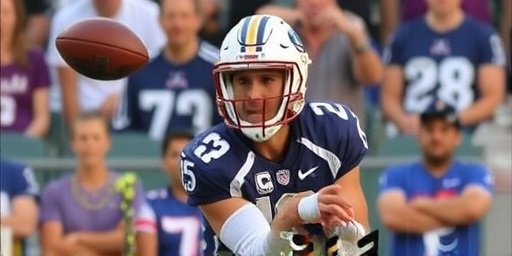In a heart-stopping moment that left fans gasping, Washington Commanders quarterback Jayden Daniels suffered a dislocated elbow during a high-stakes NFL matchup against the Philadelphia Eagles, casting a shadow over the team’s surging playoff aspirations. The injury, which occurred in the third quarter of Sunday’s game, sidelined the star rookie and sparked immediate concerns about his recovery timeline and the broader impact on the Commanders’ football season.
Daniels, the No. 2 overall pick in the 2024 NFL Draft, was leading a drive when Eagles linebacker Nakobe Dean sacked him awkwardly, twisting his right arm in a way that medical experts describe as a classic posterior dislocation. Trainers rushed to the field as Daniels clutched his elbow in agony, and he was carted off after a brief evaluation. X-rays and an MRI later confirmed the dislocation without accompanying fractures, but the setback has everyone from coaches to analysts pondering the road ahead.
This injury to Jayden Daniels comes at a pivotal time, with the Commanders holding a 7-3 record and clinging to the NFC East lead. Without their dynamic dual-threat quarterback, who has thrown for 2,150 yards and rushed for 650 this season, the team’s offensive firepower could dim significantly.
Gruesome Sack Details: The Play That Changed Everything
The incident unfolded with 8:42 left in the third quarter, as Daniels dropped back to pass on a second-and-seven from the Eagles’ 45-yard line. Eyeing a deep shot to wide receiver Terry McLaurin, he stepped up in the pocket but was met by a blitzing Dean, who wrapped around from the blind side. The 245-pound linebacker drove into Daniels’ extended arm, hyperextending the joint with a sickening pop audible even on broadcast replays.
Witnesses, including Commanders head coach Dan Quinn, described the scene as chaotic. ‘It was one of those hits where time slows down,’ Quinn said in his post-game presser. ‘Jayden fought through it initially, but you could see the pain etched on his face. Our hearts sank.’ Daniels himself, speaking briefly from the locker room before being transported to the hospital, managed a thumbs-up to teammates but admitted the discomfort was ‘unlike anything I’ve felt.’
Football purists will note this isn’t Daniels’ first brush with physical adversity. During his college days at LSU, he dealt with a lingering ankle issue that tested his mobility. But this elbow injury strikes at the core of his playing style— a blend of pinpoint passing and elusive scrambling that has drawn comparisons to a young Lamar Jackson. Stats from the game up to that point showed Daniels completing 14 of 18 passes for 185 yards and a touchdown, underscoring how his absence shifted the momentum. The Commanders lost 24-17, their first defeat in four weeks, highlighting the immediate ripple effects.
League officials reviewed the play but deemed it legal, though Daniels’ camp has hinted at exploring concussion protocols as a precaution, given the force of the impact. For now, the focus remains on stabilizing the joint, with initial reports indicating no ligament tears but potential nerve involvement that could complicate recovery.
Elbow Dislocation Breakdown: What Doctors Say About Healing Time
Medically speaking, a dislocated elbow is a serious but manageable injury in the world of professional football. Orthopedic specialists explain that the humerus bone pops out of its socket at the elbow, often requiring manual reduction under sedation to reposition it. In Daniels’ case, team physicians performed this procedure swiftly at the stadium, followed by immobilization in a splint.
According to Dr. James Andrews, a renowned sports medicine expert who has treated countless NFL stars, the average recovery timeline for a simple dislocation without fractures is 4-6 weeks for basic function, but full throwing motion could take 8-12 weeks. ‘For a quarterback like Jayden, whose arm is his livelihood, we’re talking conservative rehab to avoid stiffness or instability,’ Andrews noted in a recent interview with ESPN. ‘Rushing back risks chronic issues, like valgus instability that plagues many players.’
Historical precedents abound in the NFL. Remember Drew Brees’ 2005 elbow dislocation? He missed just four games but underwent extensive therapy. More recently, Buffalo Bills QB Josh Allen nursed a UCL sprain in his elbow last season, returning in eight weeks after platelet-rich plasma injections. Daniels’ situation appears less severe—no UCL tear confirmed yet—but swelling and bruising around the joint suggest a cautious approach.
The Commanders’ medical staff has outlined a multi-phase rehab plan: Phase one involves rest and ice for the first 48 hours, followed by gentle range-of-motion exercises by week two. By month one, light throwing drills could resume if imaging shows progress. Nutrition plays a role too; Daniels, already on a high-protein diet to support his 6-foot-4, 210-pound frame, will incorporate anti-inflammatory supplements like turmeric and omega-3s.
Statistics from the NFL Players Association indicate that elbow injuries sideline quarterbacks for an average of 6.2 games, with 70% returning to pre-injury performance levels. For Jayden Daniels, whose rookie contract is worth $36.4 million guaranteed, the stakes are financial as well as athletic. Insurance policies cover such setbacks, but prolonged absence could affect endorsements from brands like Nike and Gatorade.
- Week 1-2: Immobilization and pain management
- Week 3-6: Physical therapy focusing on flexion and extension
- Week 7+: Progressive return to throwing, monitored by biomechanics experts
Optimism abounds, with Daniels posting on Instagram: ‘One day at a time. Grateful for the support. #HTTR’—a nod to the team’s ‘Hail to the Redskins’ mantra, now rebranded.
Commanders’ Offense in Turmoil: Backup Plans and Playoff Math
With Jayden Daniels out, the Washington Commanders face an uphill battle to maintain their NFC wildcard spot. Backup quarterback Marcus Mariota, a veteran with experience from the Raiders and Titans, stepped in seamlessly during the Eagles game, completing 8 of 12 passes for 92 yards. But Mariota’s mobility doesn’t match Daniels’, and the offense, which ranks 5th in yards per game (378.2), relies heavily on the rookie’s designed runs.
Analysts crunching the numbers paint a grim picture. Pro Football Focus projects a 25% drop in offensive efficiency without Daniels, based on similar injuries in prior seasons. The Commanders’ schedule toughens with games against the Cowboys, Giants, and 49ers looming— all potential playoff contenders. Currently at 7-3, they lead the NFC East by one game over Dallas, but a Daniels-less stretch could see them slip to the No. 6 seed or worse.
Coach Quinn addressed the media with resolve: ‘We’ve prepared for every scenario. Marcus is ready, and our defense—top-10 in points allowed—will carry us.’ Indeed, the unit, led by rookie DE Jonathan Allen, has forced 18 turnovers this year. Running back Brian Robinson Jr., who rushed for 105 yards in the loss, could see an expanded role in a ground-and-pound scheme.
Team insiders reveal contingency plans include signing free-agent QB Jacoby Brissett as a bridge option, should Mariota falter. Fan reactions on social media are mixed: #PrayForJayden trends with over 50,000 posts, but skepticism about the backups abounds. One viral tweet read, ‘Commanders were contenders; now we’re pretenders without JD.’
Playoff implications extend league-wide. The NFC is a bloodbath, with the Eagles, Lions, and Vikings all above .700. If Daniels misses 4-6 weeks, the Commanders might need to win 3 of their next 5 to stay alive, per ESPN’s Football Power Index, which now gives them just a 62% chance of postseason berth—down from 78% pre-injury.
Daniels’ Rookie Rise: From Heisman Glory to Injury Setback
Jayden Daniels‘ ascent to NFL stardom was nothing short of meteoric. The 23-year-old from Cajon High School in California won the Heisman Trophy in 2023 at LSU, throwing for 3,812 yards and 40 touchdowns while adding 1,134 rushing yards. Drafted second overall, he inked a deal that made him the highest-paid rookie QB, and his early pro stats—66.5% completion rate, 12 TDs, 4 INTs—validated the hype.
Yet, football’s brutality has a way of humbling even the brightest stars. This elbow injury echoes the setbacks of predecessors like Robert Griffin III, another mobile QB who struggled with injuries during his Commanders tenure. Daniels, however, brings a maturity beyond his years, crediting his family’s support and a sports psychologist for mental fortitude.
Off the field, Daniels is a cultural force. His ‘JD Dreams’ foundation aids underserved youth in sports, and he’s collaborated with rapper Lil Wayne on motivational content. Post-injury, endorsements haven’t wavered; Pepsi renewed his deal, citing his ‘resilient spirit.’
Looking at comparable recoveries, Cincinnati’s Joe Burrow returned from a 2020 knee injury to lead the Bengals to the Super Bowl. Daniels could follow suit, using this time for film study and leadership growth. Teammates rally around him: ‘He’s our engine,’ McLaurin said. ‘We’ll keep the car running till he’s back.’
As the Commanders navigate this storm, the NFL calendar marches on. Daniels’ rehab updates will dominate headlines, with weekly reports expected from the team’s Ashburn facility. If he beats the odds and returns by Week 14, the playoff push could reignite. Fans, hold your breath—Washington’s season hangs on one arm’s healing.









